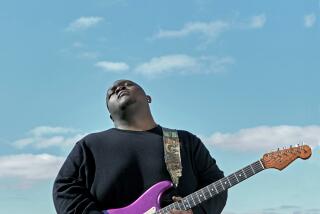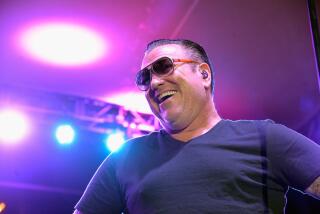Allan Holdsworth, electric guitar innovator, dies at 70
Allan Holdsworth, an innovative and influential electric guitarist who helped shape everything from progressive rock to jazz over the past half century, died Sunday at his home in north San Diego County. He was 70.
Holdsworth, who the late composer and musician Frank Zappa once said deserved credit for âsingle-handedly reinventing the electric guitar,â played in a number of groups, from Soft Machine to the progressive rock band U.K.
His death brought immediate tributes from other musicians, including guitar star Joe Satriani, who tweeted: âR.I.P. Allan Holdsworth. You remain an enormous inspiration to me. Your beautiful music will live on forever.â
Living Colour guitarist Vernon Reid tweeted: âHow many guitarists, upon hearing #AllanHoldsworth the FIRST time, put their guitars in cases, NEVER to be opened again? Literally, Jaw Dropping.â
And former Dream Theater drummer Mike Portnoy tweeted: âRIP Allan Holdsworth... One of the all-time greats and innovators...no Holdsworth = no Eddie Van Halen #UK #OneOfAKindâ
Whether playing a conventional electric guitar or a guitar synthesizer, Holdsworth soared. He created wonderfully distinct music that drew from jazz, rock and contemporary classical music. At his best, he came close to transcending all three.
Holdsworthâs astounding fluency was matched by the intense emotion he brought to his playing. He cleanly articulated every note, no matter how accelerated the tempo or deviously constructed the song structure. And, when playing ballads, he created gently swelling chords that made ingenious use of space and silence.
His advanced approach to harmony and his blindingly fast and intricate legato style left even some of the worldâs greatest guitarists shaking their heads in awe.
âAllan plays things so advanced I canât even understand some of it, and Iâve let him know that,â John McLaughlin told the San Diego Union-Tribune in 2003.
Holdsworth, who did few interviews in recent years, appreciated the praise of his peers. He was also quick to deflect the kudos that so often came his way.
âItâs obviously flattering when somebody likes something one is doing,â he said in a 2000 Union-Tribune interview. âBut at the same time, I get embarrassed about it. Itâs the âIâm not worthy syndrome.â Iâm a very tough critic of my guitar-playing. Sometimes I donât even want to do it anymore.â
An April 10 performance in San Marcos was the last of several Southern California shows he did, performances timed to celebrate the release of his two new Manifesto Records releases: âEidolon: The Allan Holdsworth Collection,â a two-CD collection, and âThe Man Who Changed Guitar Forever,â a 12-CD box set.
Zappa was not alone in his admiration of Holdsworth.
âHe is the best in my book,â Eddie Van Halen once said of Holdsworth.
Guitarist Carlos Santana agreed, saying: âHe has something totally beautiful. I give him more credit than anyone for just pure expression in soloing.â
Allan Holdsworth was born Aug. 6, 1946, in Bradford, a small town in Yorkshire, England. He had lived in Southern California since 1980, most recently in Vista.
Inspired by jazz greats Charlie Parker and John Coltrane, Holdsworth wanted to play saxophone as a youth but his family could not afford one.
âWhen I was 14 my dad bought a guitar from an uncle. It sat around the house; I had no interest in it. I just picked it up in moments of sheer boredom,â Holdsworth recalled in a 1987 Union-Tribune interview.
âI wanted to play a wind instrument, because it was closer to the human voice than anything else. You can shape the sound by blowing, as opposed to a percussive instrument like the guitar. That is why I tried very hard to make the guitar a non-percussive instrument.â
He made his recording debut in 1969 on âIgginbottomâs Wrench,â the sole album by the English band Igginbottom.
In the 1970s, Holdsworth gained acclaim as a daring and fleet-fingered guitarist in such English bands as Tempest and Soft Machine, and on albums with French violinist Jean Luc Ponty and the Anglo-French band Gong.
In the mid-1970s Holdsworth joined the New Tony Williams Lifetime, a jazz-rock fusion quartet led by former Miles Davis drummer Williams. His first album with Williams, 1975âs classic âBelieve It,â introduced Holdsworth to American listeners. He continued to play songs from that album throughout his career, including âFred,â the opening song at his April 10 concert in San Marcos.
Holdsworth greatly impressed jazz guitar giant George Benson at a 1975 New York club date.
âHe sure has made an impression on me; he does things I have not heard the guitar do,â said Benson, who subsequently got Holdsworth his first solo record deal. âHeâs not trying new things, heâs mastering them.â
The result of his meeting with Benson was the 1976 album âVelvet Darkness.â Holdsworth quickly disowned it because the album consisted entirely of studio rehearsal sessions, not the final tracks.
Even greater attention came to Holdsworth after he co-founded the jazzy progressive-rock band U.K. in 1977. It teamed him with former Yes drummer Bill Bruford, former Roxy Music violinist and keyboardist Eddie Jobson, and the late King Crimson singer and bassist John Wetton.
Holdsworth recorded his second solo album, âI.O.U.,â in 1980. He made at least 13 more albums over the next two decades, including 1985âs âMetal Fatigue.â Its title song has been credited by Rage Against the Machine guitarist Tom Morello as the single most influential piece of music that shaped his own guitar style.
âIt was the first time I heard someone go outside of the expected melodic parameters, and that sounded fantastic to me,â Morello told Music Radar.
Holdsworth also had a major impact as a guitar designer. His signature Holdsworth H2 semi-hollow electric guitar model has been a bestseller since Carvin Guitars of Escondido first began marketing it in 1996.
Holdsworth is survived by his daughters, Emily and Louise; a son, Sam; and a granddaughter.
George Varga writes for the San Diego Union-Tribune
More to Read
Start your day right
Sign up for Essential California for the L.A. Times biggest news, features and recommendations in your inbox six days a week.
You may occasionally receive promotional content from the Los Angeles Times.






